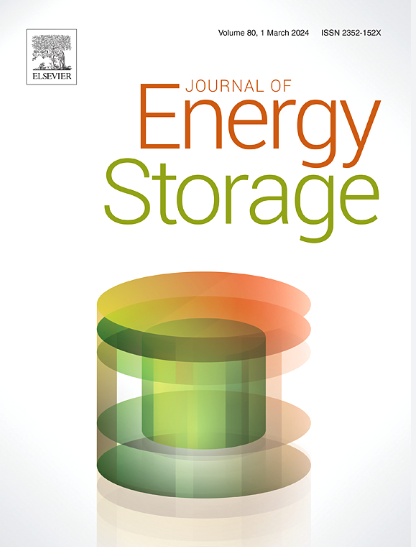锯齿形中间板存在时三管潜热储能装置熔化凝固机理的数值分析
IF 8.9
2区 工程技术
Q1 ENERGY & FUELS
引用次数: 0
摘要
本研究利用数值模拟方法评估了三管潜热储能系统的热性能,重点研究了锯齿形中间板对潜热储能系统的影响。它评估了各种几何构型、相变材料(PCM)类型和传热流体(HTF)特性对熔化和凝固循环的影响。锯齿形结构显著影响换热速率,提高相变机制的效率。RT-35成为最有效的PCM,展示了其优越的热性能,并突出了PCM选择的重要性。此外,优化的HTF参数,如较高的进口温度和雷诺数,改善了熔化过程,而较低的温度加速了凝固。其中,锯齿形振幅为7.5 mm的Case 5不仅熔化时间缩短了20.54%,蓄热量提高到92.48 W,而且凝固性能与形态A5相当,凝固时间最短,为4949 s,放热率最高,为77.18 W。雷诺数为1500进一步改善了熔化和凝固过程。利用RT-35作为PCM,最大限度地提高了相变速度和储热效率。这些发现说明了几何设计、材料特性和操作参数之间至关重要的相互作用,从而提高了潜热储能系统的性能。这一分析为设计和运行更高效的热能储存解决方案、推进可再生能源储存技术以解决间歇性问题和支持可持续能源转型提供了有价值的见解。本文章由计算机程序翻译,如有差异,请以英文原文为准。
Numerical analysis of melting/solidification mechanism in a triple-pipe latent heat energy storage unit in the presence of a zig-zag shaped middle plate
This study evaluates the thermal performance of a triple-pipe latent heat energy storage system using numerical simulations, with a focus on the effects of a zig-zag shaped middle plate. It assesses the impact of various geometric configurations, phase change material (PCM) types, and heat transfer fluid (HTF) characteristics on the melting and solidification cycles. The zig-zag geometry significantly affects heat transfer rates, enhancing the efficiency of the phase change mechanism. RT-35 emerged as the most effective PCM, demonstrating its superior thermal properties and highlighting the importance of PCM selection. Additionally, optimal HTF parameters, such as higher inlet temperatures and Reynolds numbers, improved the melting process, while lower temperatures accelerated solidification. Specifically, Case 5 with a zig-zag amplitude of 7.5 mm not only excelled in melting efficiency by reducing melting time by 20.54 % and increasing heat storage to 92.48 W but also achieved the best solidification performance alongside configuration A5, with the shortest time of 4949 s and the highest heat release rate of 77.18 W. A Reynolds number of 1500 further improved both melting and solidification processes. Utilizing RT-35 as the PCM maximized the speed of phase transition and thermal storage efficiency. These findings illustrate the crucial interplay between geometric design, material properties, and operational parameters, enhancing the performance of latent heat energy storage systems. This analysis offers valuable insights for designing and operating more efficient thermal energy storage solutions, advancing renewable energy storage technologies to address intermittency and support sustainable energy transitions.
求助全文
通过发布文献求助,成功后即可免费获取论文全文。
去求助
来源期刊

Journal of energy storage
Energy-Renewable Energy, Sustainability and the Environment
CiteScore
11.80
自引率
24.50%
发文量
2262
审稿时长
69 days
期刊介绍:
Journal of energy storage focusses on all aspects of energy storage, in particular systems integration, electric grid integration, modelling and analysis, novel energy storage technologies, sizing and management strategies, business models for operation of storage systems and energy storage developments worldwide.
 求助内容:
求助内容: 应助结果提醒方式:
应助结果提醒方式:


